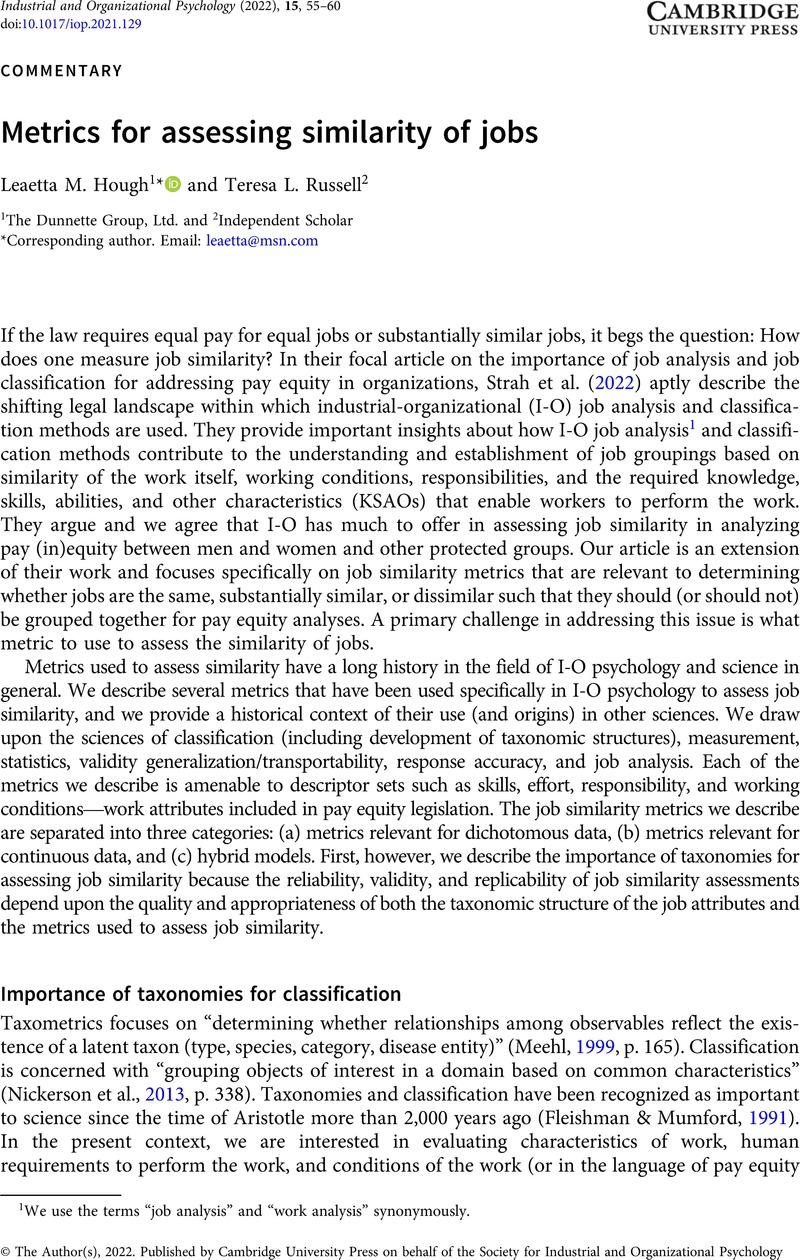No CrossRef data available.
Article contents
Metrics for assessing similarity of jobs
Published online by Cambridge University Press: 29 March 2022
Abstract
An abstract is not available for this content so a preview has been provided. Please use the Get access link above for information on how to access this content.

- Type
- Commentaries
- Information
- Copyright
- © The Author(s), 2022. Published by Cambridge University Press on behalf of the Society for Industrial and Organizational Psychology
References
Albatineh, A. N., & Niewiadomska-Bugaj, M. (2011). Correcting Jaccard and other similarity indices for chance agreement in cluster analysis. Advances in Data Analysis and Classification, 5(3), 179–200.Google Scholar
Ash, R. A., & Levine, E. L. (1980). A framework for evaluating job analysis methods. Personnel, 57(6), 53–59.Google Scholar
Beers, R. J., & Lockhart, W. R., (1962). Experimental methods in computer taxonomy. Journal of General Microbiology, 28(4), 633–640.CrossRefGoogle ScholarPubMed
Brusco, M., Cradit, J. D., & Steinley, D. (2021). A comparison of 71 binary similarity coefficients: The effect of base rates. PLoS ONE, 16(4): e0247751. https://doi.org/10.1371/journal.pone.0247751Google ScholarPubMed
Cheetham, A. H., & Hazel, J. E. (1969). Binary (presence-absence) similarity coefficients. Journal of Paleontology, 43(5), 1130–1136.Google Scholar
Choi, S.-S., Cha, S.-H., & Tappert, C. C. (2010). A survey of binary similarity and distance measures. Systemics, Cybernetics, and Informatics, 8(1), 43–48.Google Scholar
Cronbach, L. J., & Gleser, G. C. (1953). Assessing similarity between profiles. Psychological Bulletin, 50(6), 456–473.CrossRefGoogle ScholarPubMed
Driver, H. E., & Kroeber, A. L. (1932). Quantitative expression of cultural relationship. University of California Publications in American Archaeology and Ethnology, 31(4), 211–256.Google Scholar
Fleishman, E. A. (1975). Toward a taxonomy of human performance. American Psychologist, 30(12), 1127–1149.Google Scholar
Fleishman, E. A., & Quaintance, M. K. (1996). Taxonomies of human performance. Management Research Institute.Google Scholar
Fleishman, E. A., & Mumford, M. D. (1991). Evaluating classifications of job behavior: A construct validation of the ability requirement scales. Personnel Psychology, 44(3), 523–575.CrossRefGoogle Scholar
Garwood, M. K., Anderson, L. E., & Greengart, B. J. (1991). Determining job groups: Application of hierarchical agglomerative cluster analysis in different job analysis situations. Personnel Psychology, 44(4), 743–762. https://doi.org/10.1111/j.1744-6570.1991.tb00697.x
CrossRefGoogle Scholar
Gibson, W. M. (1999, April 29 – May 2). Transporting validity for cognitive ability tests for all clerical jobs. In Hoffman, C.,
McPhail, M., Tippins, N., & Gibson, W. M., (Eds.), Transporting validity in the real world [Preconference workshop]. The 14th Annual Conference of the Society for Industrial and Organizational Psychology, Atlanta, GA.Google Scholar
Gibson, W. M., & Caplinger, J. A. (2007). Transportation of validation results. In McPhail, M. (Ed.), Alternative validation strategies: Developing new and leveraging existing validity evidence (pp. 29–81). Jossey-Bass.Google Scholar
Jaccard, P. (1912). The distribution of the flora in the alpine zone. New Phytologist, 11(2), 37–50.CrossRefGoogle Scholar
John, O. P., Angleitner, A., & Ostendorf, F. (1988). The lexical approach to personality: A historical review of trait taxonomic research. European Journal of Personality, 2(3), 171–203.CrossRefGoogle Scholar
Legree, P. J., Psotka, J., Robbins, J., Roberts, R. D., Putka, D. J., & Mullins, H. M. (2014). Profile similarity metrics as an alternate framework to score rating-based tests: MSCEIT reanalyses. Intelligence, 47, 159–174. https://doi.org/10.1016/j.intell.2014.09.005
CrossRefGoogle Scholar
Levine, E. L., & Sanchez, J. I. (2012). Evaluating work analysis in the 21st century. In Wilson, M. A., Bennett, W. Jr., Gibson, S. G., & Alliger, G. M. (Eds.), The handbook of work analysis: Methods, systems, applications and science of work Measurement in Organizations (chap. 7, pp. 127–138). Routledge
Google Scholar
McDaniel, M. A., Psotka, J., Legree, P. J., Yost, A. P., & Weekley, J. A. (2011). Toward an understanding of situational judgment item validity and group differences. Journal of Applied Psychology, 96(2), 327–336.CrossRefGoogle ScholarPubMed
Meehl, P. E. (1999). Clarifications about taxonmetric method. Applied & Preventive Psychology, 8(3), 165–174.CrossRefGoogle Scholar
Nickerson, R. C., Varshney, U., & Muntermann, J. (2013). A method for taxonomy development and its application in information systems. European Journal of Information Systems, 22(3), 336–359.CrossRefGoogle Scholar
Ochiai, A. (1957). Zoogeographic studies on the soleoid fishes found in Japan and its neighboring regions. Bulletin of the Japanese Society for Fish Science, 22(4), 526–530.Google Scholar
Osgood, C. E., & Suci, G. J. (1952). A measure of relation determined by both mean difference and profile information. Psychological Bulletin, 49(3), 251–262.CrossRefGoogle ScholarPubMed
Peters, J. A. (1968). A computer program for calculating degree of biogeographical resemblance between areas. Systematic Zoology, 17(1), 65–69.CrossRefGoogle Scholar
Salvatore, S., Rand, K. D., Grytten, I., Ferkingstad, E., Domanska, D., Holden, L., Gheorghe, M., Mathelier, A., Glad, I., & Sandve, G. K. (2020). Beware the Jaccard: The choice of similarity measure is important and non-trivial in genomic colocalisation analysis. Briefings in Bioinformatics, 21(5) 1523–1530. https://doi.org/10.1093/bib/bbz083
CrossRefGoogle ScholarPubMed
Strah, N., Rupp, D. E., & Morris, S. (2022). Job analysis and job classification for addressing pay inequality in organizations: Adjusting our methods within a shifting legal landscape. Industrial and Organizational Psychology: Perspectives on Science and Practice, 15(1), 1–45.Google Scholar
Stribling, J. B., Moulton, S. R. II, & Lester, G. T. (2003). Determining the quality of taxonomic data. Journal of North American Benthological Society, 22(4), 621–631.CrossRefGoogle Scholar
Szopinski, D., Schoormann, T., & Kundisch, D. (2019, June 8–14). Because your taxonomy is worth it: Towards a framework for taxonomy evaluation [Paper presentation]. Proceedings of the European Conference on Information Systems (ECIS), Stockholm-Uppsala, Sweden.Google Scholar
Tawney, M. (2017). NCJOSI 2 transportability report: Lubbock, TX Police Department. Industrial/Organizational Solutions.Google Scholar
Tett, R. P., Guterman, H. A., Bleier, A., & Murphy, P. J. (2000). Development and content validation of a “hyperdimensional” taxonomy of managerial competence. Human Performance, 13(3), 205–251.CrossRefGoogle Scholar
Warrens, M. J. (2008). On similarity coefficients for 2 × 2 tables and correction for chance. Psychometrika, 73(3), 487–502.CrossRefGoogle Scholar
Warrens, J. J. (2019). Similarity measures for 2 × 2 tables. Journal of Intelligent & Fuzzy Systems, 36(4), 3005–3018.CrossRefGoogle Scholar




